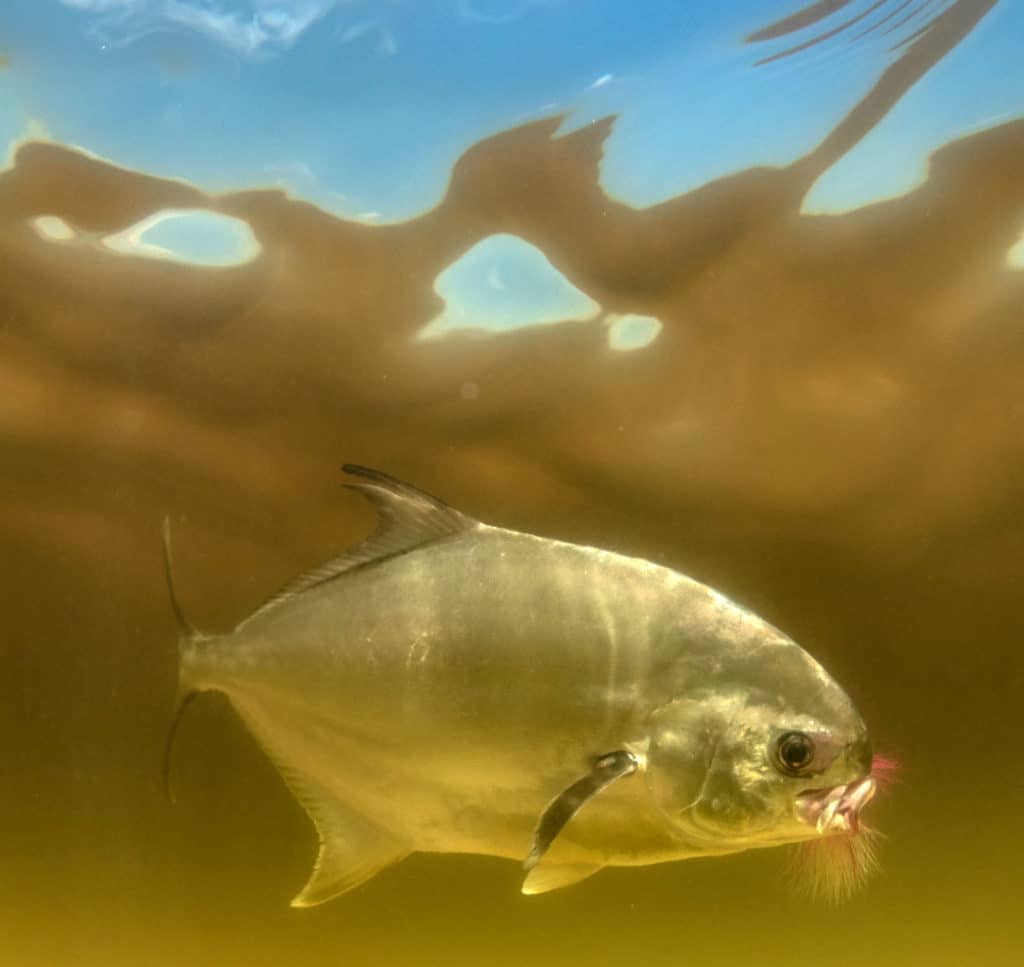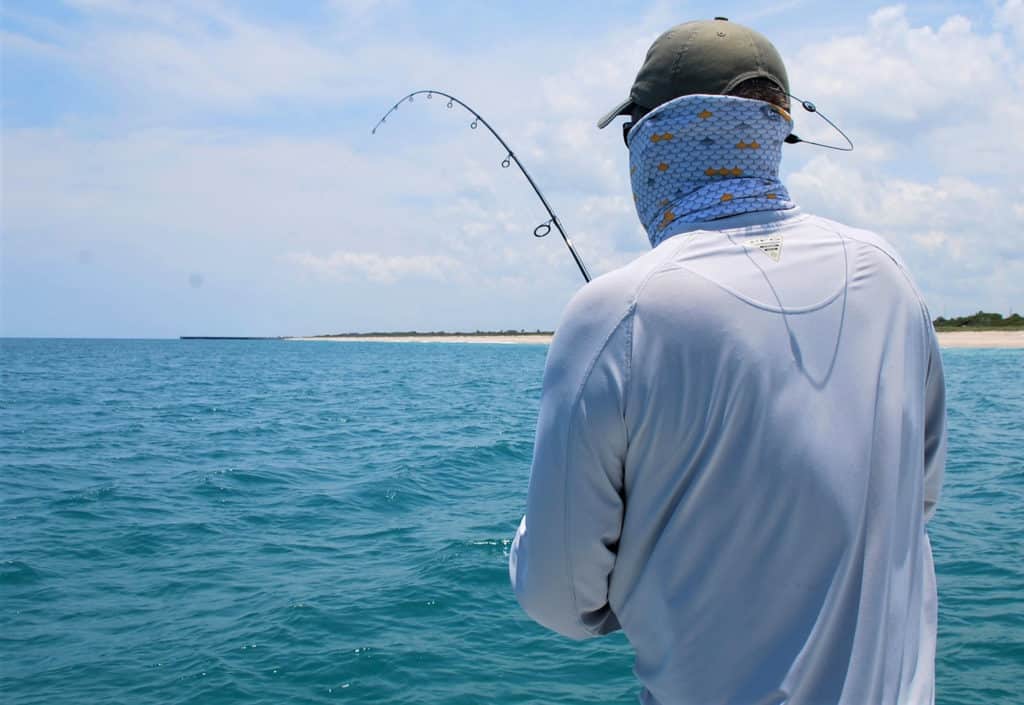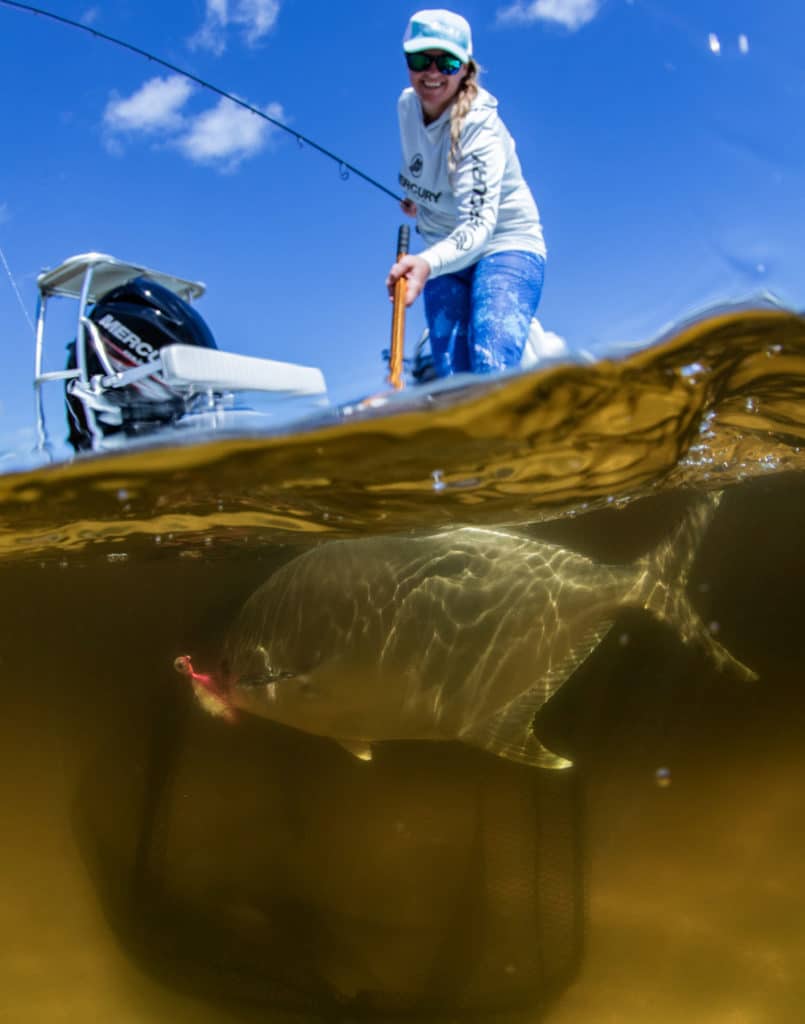
Considered a dining delicacy, pompano congregate during late winter and early spring along Florida’s central and south Atlantic coasts. And that causes anglers to assemble as well.
Capt. Glyn Austin says he commonly sees as many as 30 boats and numerous surf anglers fishing off the beach south of Sebastian Inlet from now through April.
“It’s a combination of things,” says Austin, a Central Florida native who guides anglers in the Indian River Lagoon as well as offshore of Sebastian Inlet. “The water temps are cooler for them. We get the shrimp moving through in the same timeframe—around the full moon. And there’s an abundance of sand fleas along the beaches as well.”

Beachfront Bonanza
The pompano prefer 65- to 75-degree water temperatures, although Austin likes to see the mercury climb above 70. The bottom structure off the beach in this region also draws these fish, primarily because it attracts all types of prey, including shrimp and baitfish.
“As you go out around the tip of the south jetty, down to about a half mile, there are sand bars and reef ledges, and they hold a lot of bait throughout the winter months,” Austin says. “The fish will just stay in that little pocket, and they’ll feed pretty much all winter and spring.”
Austin says most anglers fishing from boats use Doc’s Goofy Jigs in pink, orange or green, or something similar. “To me the color really means a lot,” he says. “There can be something there stirring that bottom up, and they’re going to go inspect it. If they see something brightly colored, they’re going to jump on it.

If he uses a pink or orange goofy jig, he adds a bright-green quill. If he uses a green jig, he adds a pink quill. “I tie a loop knot and run the tag end through the little quill and then through the eye of the goofy jig so they’re both tied into the same loop,” he explains. “Some guys take the quill and put it a foot or so up the line. My problem with that is if the bluefish or mackerel are in there, they’ll just cut you off on that quill.”
Anglers anchor their boats on the sandbars in an area known as Monster Hole to catch the pompano that travel inside the bars to feed. Austin says surf anglers primarily use sand fleas and cut shrimp.
Some commercial fishermen actually use blanched sand fleas on a double-hook rig, if they can’t get bites on the jig. Boiling the sand fleas turns them bright pink or orange and adds additional scent to the small crabs.

Inshore Scouting
Austin notes that pompano also can be caught in Sebastian Inlet as well as on the flats in the Indian River. Austin says those fish often disperse in the river, heading as far south as Stuart and as far north as Melbourne. Anglers all the way south to Hallandale Beach see their share of pompano in the surf.
“From the T-dock inside the inlet toward where the sandbars start, you’re basically jigging the channel,” Austin says. “On an incoming tide, it’ll get a little sandy in the channel and pompano will feed on all the bait coming through, whether it’s shrimp or whatever.” The best fishing generally occurs as the tides change.
If the tide’s wrong and the pompano don’t bite, Austin targets bluefish, jacks and mackerel. “They’ll all hit goofy jigs,” he says. “We’ve even caught several bonefish on goofy jigs in the inlet.”

As the tides pick up in the inlet and the bite slows, Austin moves to the flats directly to the west and a little to the north and south. The pompano feed on top of the flat and along the edges. “And if you’ve got water running over a sand bar, they’ll feed over that bar,” he adds. “We also catch them around the spoil islands. A lot of those spoil islands have little rocks on them that hold shrimp and crabs.”
He uses the goofy jigs inshore as well as MirrOlure 3.75-inch Lil’ John soft-plastic twitchbaits, which catch everything from pompano, jacks, mackerel and bluefish to snook up to 43 inches, flounder, trout, redfish, sharks and tarpon.
When fishing off the beaches or in the Inlet in 6 to 10 feet of water, he rigs the plastic on a 3/8-ounce jighead to get it down quicker. On the flats, in 2 to 4 feet, he fishes it on a 1/4-ounce jighead. Go-to colors include watermelon red glitter and pink.
“I vertical jig it instead of twitching it side-to-side,” he says. “Make long casts away from you, let it sink to the bottom and hop it back to the boat.”
As water temperatures warm into the spring and mullet enter the lagoon, Austin sometimes catches pompano on a Rapala X-Rap Twitchin’ Mullet while he’s fishing for snook, redfish or trout.

Tackle Tips
Austin chooses a light- to medium-action, 7-foot Shimano Teramar or G.Loomis E6X spinning rod with a fast tip and a 2500 or 3000 size Shimano Stradic spinning reel spooled with 10-pound braided line. He likes the braid for detecting the often-sensitive bite of a pompano.
He ties his lures on a 2½- to 3-foot leader of 15- or 20-pound fluorocarbon, which he attaches to the main line with a double uni-knot. The fluorocarbon helps because the fish can be picky, although he risks bluefish and mackerel cut-offs. “But if you’re going to run a heavy leader and not worry about getting cut off, you’re not going to get as many fish,” he adds.
Read Next: Sebastian Inlet’s Inshore Fishing Diversity
In Florida waters, pompano must measure 11 inches from the tip of the nose to the fork of the tail, and the daily bag limit is six per person. Austin says he commonly catches fish big enough to bring home for dinner. The fish average about 13 inches, though he has caught pompano as big as 22 inches.
“We don’t get a ton of shorts usually, but if I’ve thrown back 5 to 10 percent of the pompano that I’ve caught, that’s probably a lot,” he says.
And that’s good news for anglers hoping to catch a delicious meal over the next few months.








